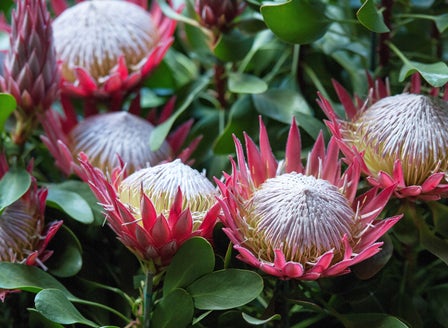As temperatures get hotter and water shortages come into play, why not consider planting an arid hot & dry garden. There are many interesting flowering and foliage plants that will tolerate these conditions. They add boldness, form and structure to our gardens.
Planting Calendar
Prepare
Position
Plants that like hot dry conditions all need a free draining loose soil and lots and lots of sun.
Soil
When planted into the ground provide a free draining soil that is rich in organic matter. To improve the organic content in your soil, break up the soil and add Kings Compost and Kings Sheep Pellets then mix together well. When growing in containers, plant into Kings Container mix. This mix contains added water storage crystals and Saturaid, two products that help maintain moisture in the soil.
Plant
When planting into the ground, gently tap the plant out of its pot. Dig a hole twice the depth and width of the plants root ball. Mix Kings Compost into your existing soil at a 50/50 ratio, add Sheep Pellets and then mix together well. Back fill the hole with this soil, so that when planted the top of the plant’s roots sit level with the surrounding ground. Firm the soil down gently and water in well with Aquaticus Organic Garden Booster. In heavier clay soils, where drainage is likely to be an issue, plant onto a raised mound and sprinkle Gypsum Clay Breaker into the bottom of the hole, this helps slowly condition the soil and help to break down the clay. When planting into containers plant into Kings Containers mix, as this has water retention crystals in it, which will help in keeping the soil moist. Firm the soil down gently and water in well with Aquaticus Organic Garden Booster.
Care
Watering
Dry arid plants require less water than others. Usually a good water during summer twice a week will suffice. Remember DO NOT water in the heat of the day – the best time is early morning and make sure you don’t water the foliage.
Feeding
Many South African and Australian species do not like alot of fertiliser, therefore a monthly application of Kings Sheep Pellets and a liquid feed with Aquaticus Garden Booster should be all that is needed.
Protecting
Protect all succulent species from slugs and snails with Tui Quash
Mulching
Mulch around the base of the plants (make sure that the mulch does not come into direct contact with the stem of the plant) with Living Earth More than Mulch. Mulching helps to reduce weeds as well as aiding the soil to retain moisture.
General Care
When using sprays, chemicals or fertilisers always read the label and follow the instructions. Apply sprays in the evening to avoid harming beneficial insects.
Expert Tip
Many Australian and South African species are tolerant of drought conditions, as well as plants from desert regions like succulents and cacti. Plants that have silvery, grey or hairy leaves are designed to thrive in hot dry conditions.
Top Varieties
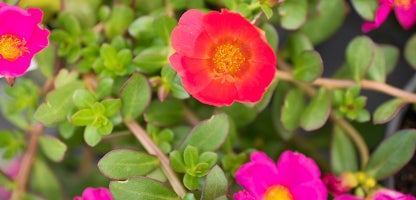
Masses of flower Portulaca
There are many flowering species that will take arid conditions. Following are some of the best to produce masses of flower. Varieties include Gazania, Echinacea, Verbena, Portulaca, Arctotis, Ice Plants.
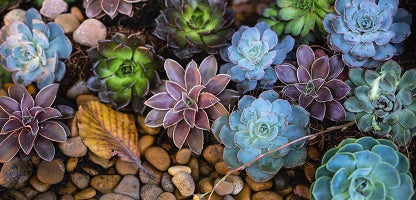
Succulents
Providing structure to the garden there are many succulents that can grow in pots, baskets or the ground making them a versatile addition to the Arid garden. Varieties include Sedum, Echeveria, Euphorbia, Agave, Frangipani, Aeonium, Aloe and Crassula.
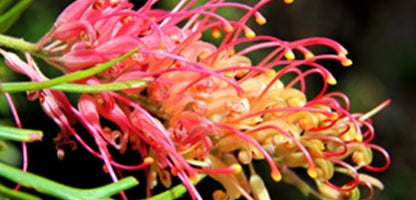
Structure species Grevillea
Varieties include Anigozanthos (Kangaroo Paw),Protea, Leucadendron, Grevillea, Banksia, Lomandra, Echium fastuosum.
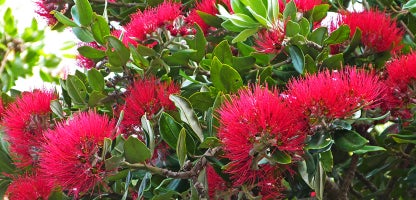
NZ Native Species Pohutukawa
Varieties include Brachyglottis, Astelia, Xeronema, Olerea, Pohutukawa, Libertia, Festuca Coxii.
Frequently Asked Questions
What plants are best suited for hot and dry gardens?
Succulents, cacti, lavender, rosemary, and ornamental grasses are excellent choices for hot and dry gardens. These plants are drought-tolerant and thrive in sunny, arid conditions.
How often should I water my hot and dry garden?
Dry arid plants require less water than others. Usually a good water during summer twice a week will suffice. Remember DO NOT water in the heat of the day – the best time is early morning and make sure you don’t water the foliage.
Can I grow vegetables in a hot and dry garden?
Absolutely. Vegetables like tomatoes, peppers, eggplants, and herbs such as thyme and oregano are well-suited for hot and dry conditions. Just ensure they get enough water during their growing season.
Is it necessary to fertilise plants in a hot and dry garden?
Many South African and Australian species do not like alot of fertiliser, therefore a monthly application of Kings Sheep Pellets and a liquid feed with Aquaticus Garden Booster should be all that is needed.
Are there any flowering plants that do well in hot and dry gardens?
Yes, many flowering plants thrive in hot, dry conditions, including marigolds, zinnias, gazanias, and bougainvillea. These plants add vibrant colour to your garden.
